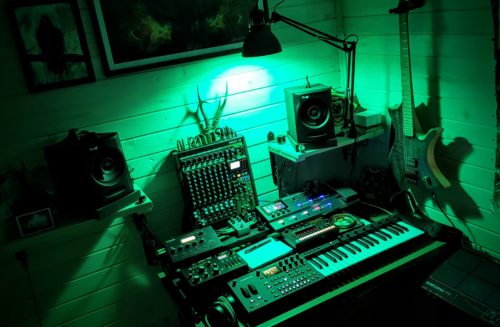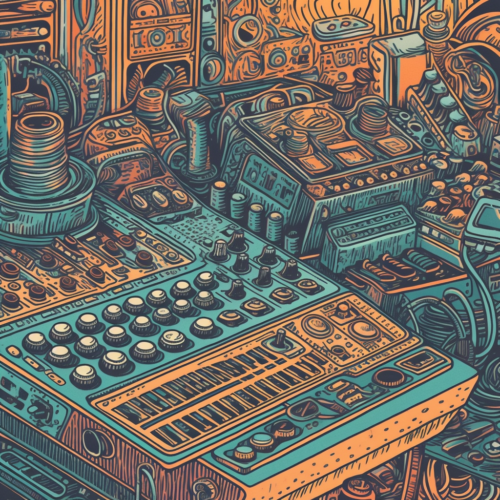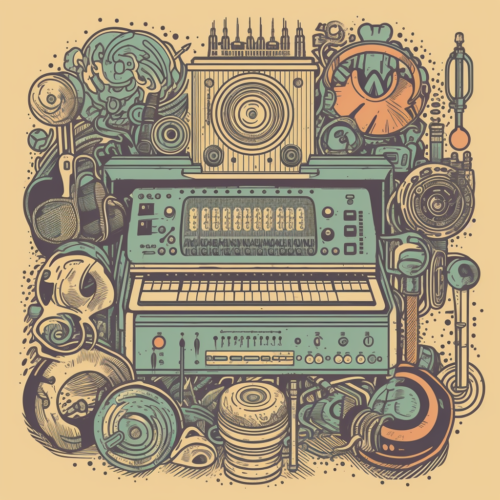There seems to be a growing trend among electronic musicians who are shying away from the Digital Audio Workstation (DAW) and choosing to do some or all of their production on hardware. There’s a bit of heated discussion behind this trend, with people trying to determine what is The Best Way to Produce Music™ and trying to make the case why you should or shouldn’t ditch the DAW.
I won’t be going down that road here. Instead, I’ll present the setup I’ve put together that works well for my workflow, and I’ll provide some pointers for consideration when it comes to putting together a hardware-based music production setup that suits your specific needs.

The Music Production Process
Let’s first take a look at the various stages of producing a recorded piece of music, so that we can determine at what point it might be beneficial to switch in or out of a DAW. The traditional stages of the music production process listed below are still applicable today for the most part.
- Composing – the initial step of developing ideas into a coherent piece of music. Each musician will have a unique workflow, but the composing stage will likely include the following: sound design, composing chords and melodies, putting together a rhythm arrangement and structure, sequencing, practicing playing the parts, and anything else that is part of the creative process. Once we’ve given up on making the composition perfect and are mostly happy with how it sounds, it’s time to hit REC.
- Recording – also called tracking, this is the process of recording all the instruments of the composition. Ideally each instrument will be recorded to a dedicated mono or stereo track, so that we can have decent flexibility when we get to mixing. Sometimes the parts/instruments will be recorded one at a time, other times they will all be recorded together in sync, or some parts such as vocals and guitars might be recorded multiple times and then layered during mixing.
- Mixing – this is the process of making all the different instruments play well together by modifying their volume and panning, and using tools such as compression and equalizing, as well as applying effects. This step requires a fair amount of technical knowledge, practice and musical feel, which is why it’s sometimes outsourced. If you prefer to do the mixing yourself, I’ve reviewed a couple of books that should get you started or improve your existing skills.
- Mastering – the final step to getting a song ready for release. There is a big benefit to having someone else do the mastering of your music, mainly for providing a fresh set of ears. But also for the fact that this step requires a fairly decent studio in terms of sound quality reproduction and acoustic treatment that few home producers are able to match. Alternatively, you can just do a bit of mastering at the end of the mixing process or apply a plugin or mastering service that will (mostly) do it for you and call it a day.
Hardware for Music Production

Electronic music production is unique for the fact that it can entirely be done with a mouse and computer. Draw some notes in the piano roll, throw down a 4/4 beat and you’ve got yourself a hit. Right?
A lot of people find it incredibly uninspiring staring at a screen and clicking a mouse to make music, especially if they’ve also got a day job that involves hours of looking at a computer screen. That’s why one of the first investments a novice producer will make is for a MIDI controller to play notes, finger drum using drum pads or use knobs and faders to trigger DAW controls.
We’ve already entered the hardware domain, so let’s take a look at some pieces of gear that every musician needs, regardless of genre:
- Audio Interface – they provide better Digital-Analog converters than what the computer has onboard and they allow for additional Audio or MIDI inputs.
- Studio Monitors – you could make the case that headphones are enough to start, but if you’re making electronic music I suspect you’ll be looking to rattle some ribcages at some point and you’ll need studio monitors for that kind of bass output.
- MIDI Controller – If you want to perform any part of a song rather than sequence it, you’ll need a controller of some kind. Usually a keyboard, but drum pads (finger or stick) are also popular for rhythm work.
Hardware Decisions for Going DAWless
Now that we’ve covered the basic requirements for a hardware setup, we’ll take a look at some optional additions that can take you further outside the DAW, depending on your specific workflow and style.
If there’s one overarching recommendation I can make it’s to limit yourself, lest you trigger the dreaded Gear Acquisition Syndrome (GAS). Entire genres were created using relatively simple gear. You’ll always get more out of learning how to better use what you already have, rather than buying that shiny new something.
Portability
This is an important decision to make right from the start, as it will hugely impact the gear that will be available to you.
- Will you be doing live sets with this setup?
- Do you want to take parts or the whole setup for making music in other places?
- How much space do you have in your studio?
Taking some time to think this through and making plans for the future will go a long way in preventing growing pains down the road.
I’ve personally limited my setup to whatever can fit on a single desk and the surrounding walls. And the floor. And the ceiling if the need arises 😁
Main Sequencer
The main function of a DAW is acting as a sequencer for all the instruments that are playing together. These are big shoes to fill for a single instrument, since it will need to able to do most of the following:
- Send MIDI to other instruments – even though most gear these days comes with onboard sequencers, it’s infinitely more practical to sequence everything from a single interface and learning how to do it well. Think about all the different instruments that will need to receive MIDI from your main sequencer
- Pattern chains – once you’ve got a couple of good patterns or parts going, you’ll need an easy way to combine them together in a flowing song. Sequencers with song mode are hugely helpful here.
- Sound engine – since this is the centerpiece of the studio, it would make sense for it to have at least some sound synthesis or sampling capability. We’ll look deeper into this in the next section.
The main brain of my setup is the Elektron Digitone Keys. I’ve used it for 2 years and have no plans to replace it, especially since the recent addition of song mode.
Synthesis vs. Samples
Do you want to make your own sounds or use existing ones – either downloaded or recorded with a field recorder? You can, of course, do both and if you choose to do so you’ll need to factor that in when thinking about what gear to get.
Drums 🥁
This question is more important when it comes to rhythm. Are you OK with just using sampled drums? Or will you need an additional (virtual) analog or FM engine to tweak drum sounds further? Luckily, most modern drum machines have most or all of the above capabilities, and more.
I’m using a Roland TR-6S for rhythm and I’ve barely touched the sound engine, choosing instead to let sampled acoustic drums do the talking in my music, together with the excellent builtin effects that Roland is renowned for.
Harmony 🎹
When it comes to monophonic (bass, leads) and polyphonic (chords) sounds, you’ll probably want to have at least some control over sound design. Samples can only take you so far.
I personally think that digital synths have reached a level where they’re indistinguishable from analog synths, especially when used in a mix. For this purpose I’m currently using the Digitone Keys for bass, chords and whatever, and I’ve got the small-but-powerful Dreadbox Typhon for leads and weird effects.
Recording

Now that the whole band of instruments is together, we’ll need to record them somehow. You could use a simple summing mixer which combines all the different inputs into a stereo track that’s ready for mastering. However, I’ve found this approach extremely limiting. Recording a performance and mixing it at the same time comes at a big cost. Often times I would do my best to produce a track that’s as close to mixed as possible, but when I enter the DAW to mix (since I’ve recorded separate stems of the instruments) I’m always blown away by how much better it sounds in every way.
That’s why my current setup involves recording everything on a Tascam Model 12 on 8 separate instrument tracks, which I then mix in the Harrison Mixbus DAW. So that’s where I break with the DAWless flow and go back in the box. Have you found a way to produce high quality mixes without a DAW? Let me know in the comments below.
I suppose the obvious question is: why not just record straight to DAW? And here’s the answer coming right at you:
- Audio interface – I would still need one of these with multiple inputs, and they ain’t much cheaper than a mixer/recorder with the same number of inputs. The pre-amps and DACs are likely to be better, but I’m perfectly satisfied with the quality of the Tascam recordings.
- Power limitations – my PC uses about 40W while the Tascam uses less than 15W. In a solar-powered studio these numbers are important.
- Always works – I switch on the Tascam and I can start recording whatever idea I have, with no worries about software updates, compatibility between gear, etc.
Note that I am not recording any acoustic sounds such as live drums, vocals or acoustic instruments. Even my electric guitar is going through a BOSS GT-001 and then straight to the mixer/recorder, without involving any amplifiers. If you need to record acoustic instruments, your setup might be different.
Another thing to consider is at what points will effects be added. The orthodox approach involves monitoring everything wet (effects on) and recording dry (effects off), and then re-applying the effects later in the DAW for maximum flexibility. Personally, I find that effects are an integral part of my sound design process so I record everything wet, or at least moist. Meaning that there’s still some room to add more delay and reverb in the mix, because more is more 💦
Whatever road you decide to go down, think about how many inputs you’ll need now and in the future, whether those are on a mixer/recorder or an audio interface.
Conclusion
Hopefully you’ve got a better idea about what gear you’ll need to put together an effective DAWless setup that works for you. My studio setup has been continually evolving since 2020 as I create and release new music. Here are some of the advantages and disadvantages I’ve come across along the way.

The Advantages of Producing on Hardware
- Tactile control – most people dismiss hardware as being just a VST in a box. Which isn’t wrong in the case of digital, but what about the box? All keys, faders, knobs and pads work seamlessly with the engine behind them which makes for a much better instrument than a MIDI controller.
- Accessibility – Flip the switch and start making music, with no software updates to worry about. Firmware updates on hardware can cause issues occasionally, but I’ve personally never had that happen to any of my gear. Nor have I had a creative onslaught stopped dead in its tracks by hardware/software issues since leaving the DAW ecosystem.
- Resale value – while hardware is generally more expensive than software plugins it also has a much better resale value, and doesn’t require regular payments to receive firmware updates. Occasionally, a discontinued piece of gear will increase in price over the years.
- Limitations – I’m a big fan of solving problems within tightly defined boundaries. This is the space where for me personally creativity flourishes.
The Disadvantages of Producing on Hardware
- Cost – software plugins have costs of their own with recurring subscriptions, but you’re still probably looking at locking up 5-10 times more money in hardware to recreate similar functionality that you would get from software alone. Also, connecting everything together has some hidden costs of its own when you factor in cables, power strips, mounts, hubs, etc.
- Space – it might seem obvious, but depending on how deep you want to go, hardware can start taking up considerable real estate.
- Limitations – there are just some things you simply won’t be able to do without a DAW. In my case, that’s mixing.
Did you find this article helpful? Did I miss something? Let me know about your adventures in the DAWless space in the comments below.
